Don’t worry, I’ll show you how to choose a domain name for your business to help you stand out from the crowd and possibly even boost your SEO. By the end of this article, you’ll be ready to register a domain and start your website ASAP.
Table of Contents
- How to Choose a Domain Name for Your Business
- What makes a good domain name?
- How to Choose a Domain Name for Your Blog
- Domain Name Generator
- Choose a Domain Name With Confidence
What makes a good domain name?
A good domain has three winning qualities:
- Memorability
- Timelessness
- SEO-friendliness
Let’s dive into what I mean.
Memorability
Your domain name is how your audience will find and remember you. The best domain names are memorable to your audience so they can easily find you again.
What makes a domain memorable?
- The shorter, the better. Try not to exceed 15 characters, not including the domain extension (e.g., .com, .org, .co).
I ran my own little study by taking the top 75 most visited websites in March 2025 according to Similarweb and asking both ChatGPT and Claude to calculate the average domain name length (not including the domain extension).
The result? 6.5 characters! - It flows off the tongue well. Try saying your domain out loud. Would someone understand what you said? Would they be able to spell it?
- It’s related to your business. Sure, popular domains like Google.com, Amazon.com, and Asana.com don’t tell you what the business does — but it’s an uphill battle to build that kind of brand recognition. An easier path is having at least one word that hints at your product or service.
Timelessness
Pick a domain name that you can see yourself keeping forever. This might seem scary, and it’s okay to change your domain later, but it’s better if you don’t — so don’t take this decision lightly.
The reason timelessness matters is that you want a domain name that doesn’t become outdated as time passes and trends change.
There’s another lesser-known reason, and it’s related to SEO: A domain name builds authority. Basically, an older domain with high-quality content becomes trusted by Google and is theoretically easier to rank.
The longer you spend with a domain and the more you build it up, the bigger the potential loss if you change it.
SEO Considerations
As well as authority, your domain name can help bolster your SEO efforts. Domains including a keyword can help websites rank.
You want to balance the benefits of using the keyword in the URL against using a brand keyword. Later, I’ll discuss the nuances of choosing keyword-rich domains, including when it’s appropriate and when to stay with the brand name.
If you’re eager to set up your website, you’ll need to register a domain. Here are seven tips for choosing your domain name.
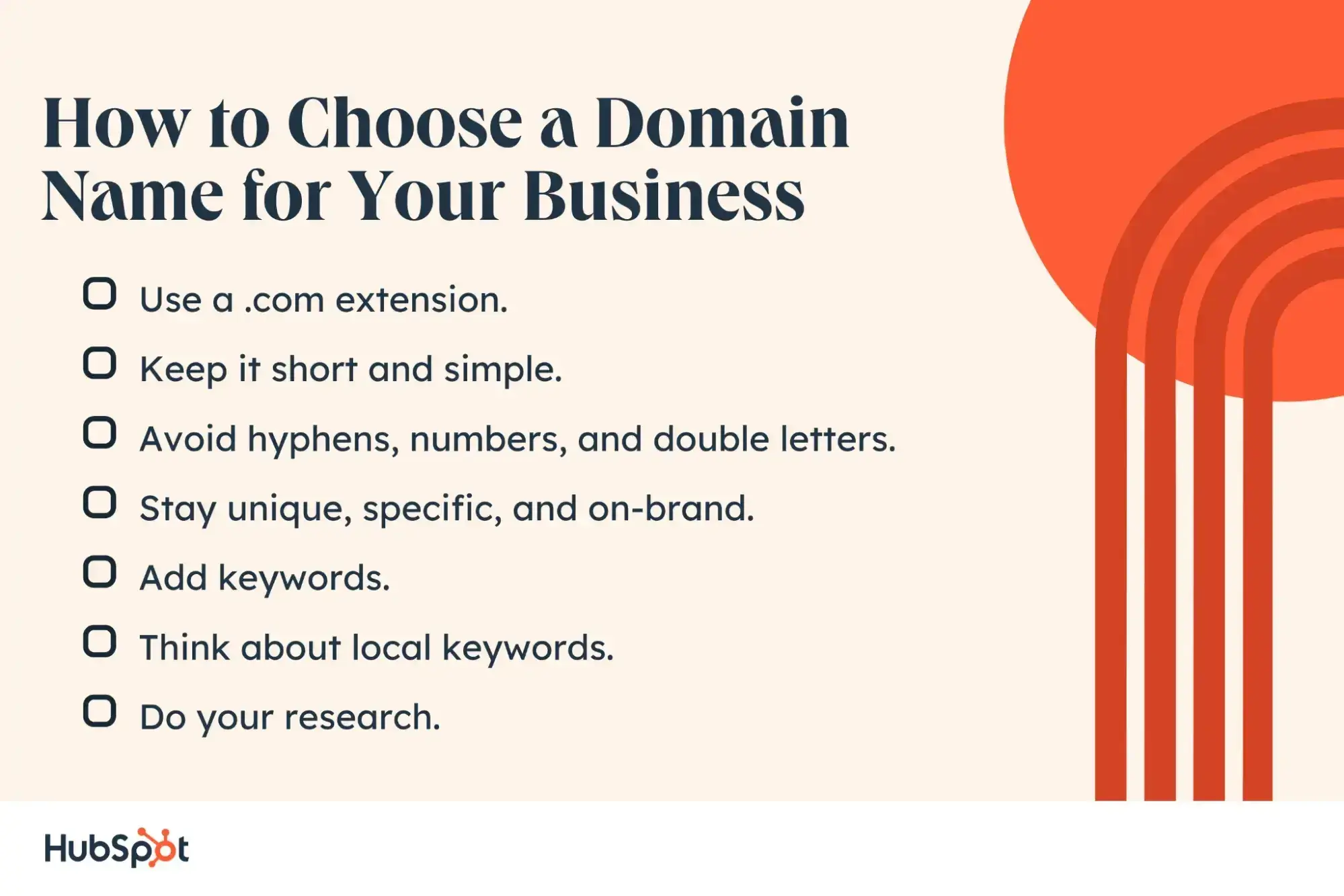
1. Use a .com extension.
You’ve surely visited many websites, and it’s not hard to see that the most popular domain extension is .com, while other trusted or common options include .org and .net. You might also want to buy other extensions to protect your brand name.
Ninety-nine percent of the time, I recommend that if .com is available — go with it. Of the many domains I’ve bought in my career, only one broke that rule: AmyRigby.com was taken, so I had to settle for AmyRigby.co.
If someone already has your .com domain extension, you can still buy .co, .net, or whatever works, but it could cause headaches later. For example, you might end up with a trademark issue. So if a .com domain extension is taken, consider a new domain altogether.
Pro tip: Most free website builders allow you to build a site for free but require a paid subscription to connect a custom domain. If you want a fully branded website, build yours on a CMS that has reliable web hosting and allows you to connect your custom domain for free.
2. Keep it short and simple.
If your domain name is long, it’ll be harder for people to remember, which could mean less traffic for you.
Beyond that, a short domain name isn’t helpful if it is hard to spell or pronounce, as users will likely lose their way when trying to type your website URL.
3. Avoid hyphens, numbers, and double letters.
Each of these elements is another hurdle for users to attempt to jump just to access your website. It’s not exactly intuitive to keep these characters in mind, and double letters can make the domain name messy and hard to read.
Not to mention, all of these elements are susceptible to becoming typos as users try to search the internet for your business website.
If you’re sharing your website via word-of-mouth with clients, it’s also much harder to convey the domain name clearly when it is jumbled with hyphens, numbers, and the same letters back-to-back.
Pro tip: It’s all about weighing the pros and cons of your decisions. The main takeaway here is this: Do not deliberately misspell your domain to get something that is technically already taken.
This is bad practice for memorability, and you might end up with a domain dispute or trademark issue later.
As mentioned before, if a domain name is taken, and you’re finding yourself trying a little too hard to secure it (e.g., buying unprofessional extensions or making spelling mistakes), it’s a sign you need to move on to a different name.
4. Stay unique, specific, and on-brand.
With all of these things to keep in mind, it can be hard to brainstorm a domain name that is clear and concise while also remaining unique and true to your business.
But it’s certainly doable. Keep your business name and what you sell at the forefront of your mind, and dig into your niche to ensure that your domain name attracts the online audience you want.
Pro tip: I’ve used ChatGPT to help me brainstorm domain name ideas. Using a fake scenario, here’s an example of what I’d ask ChatGPT.
My prompt: “Give me a list of good domain names for a budget travel blog. Make them memorable, easy to spell and pronounce, and keyword rich. Keep each domain name under 25 characters.”
ChatGPT came up with some great starting points.
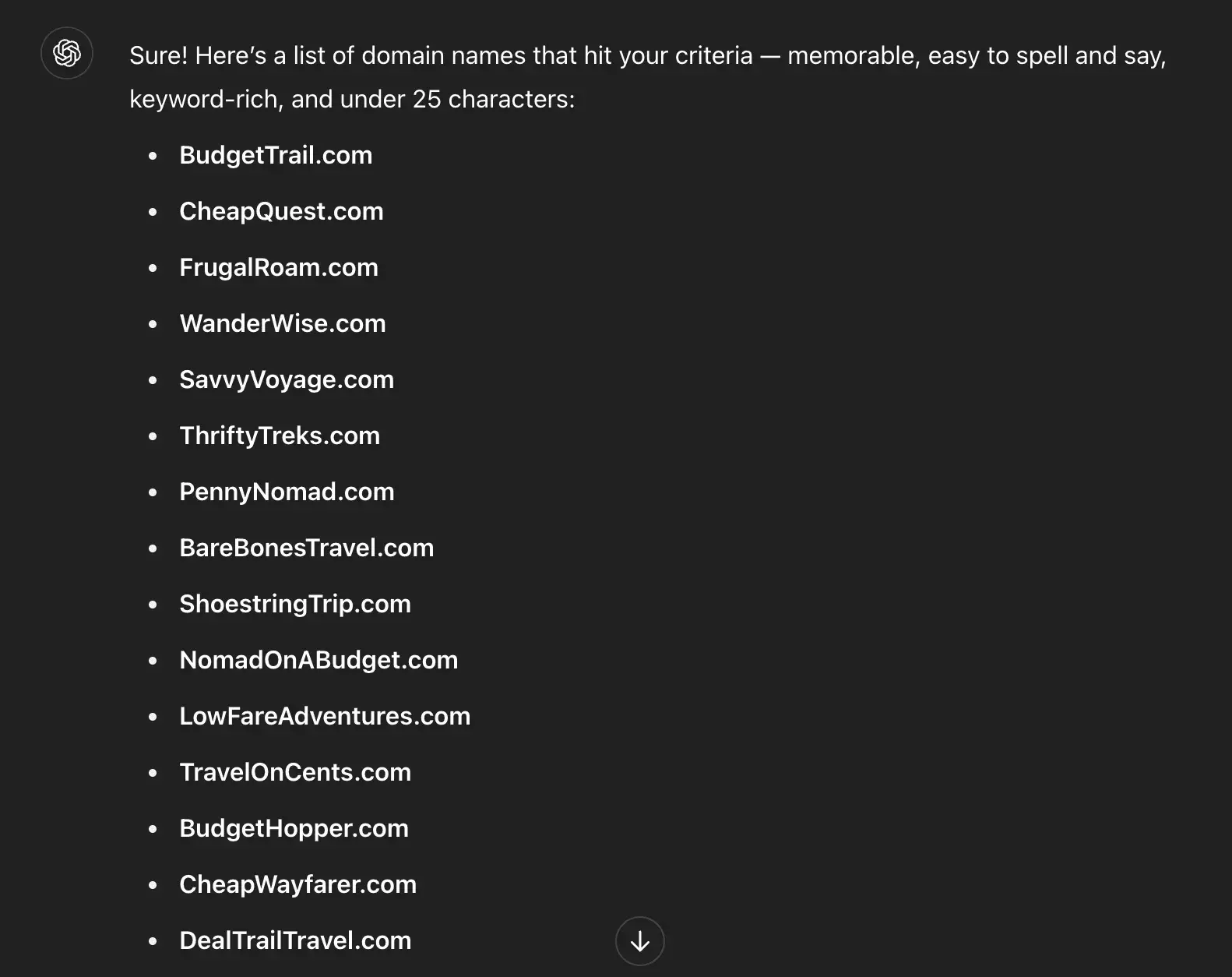
From there, all I had to do was copy the list and paste it into Namecheap’s bulk domain search to see which ones were available.
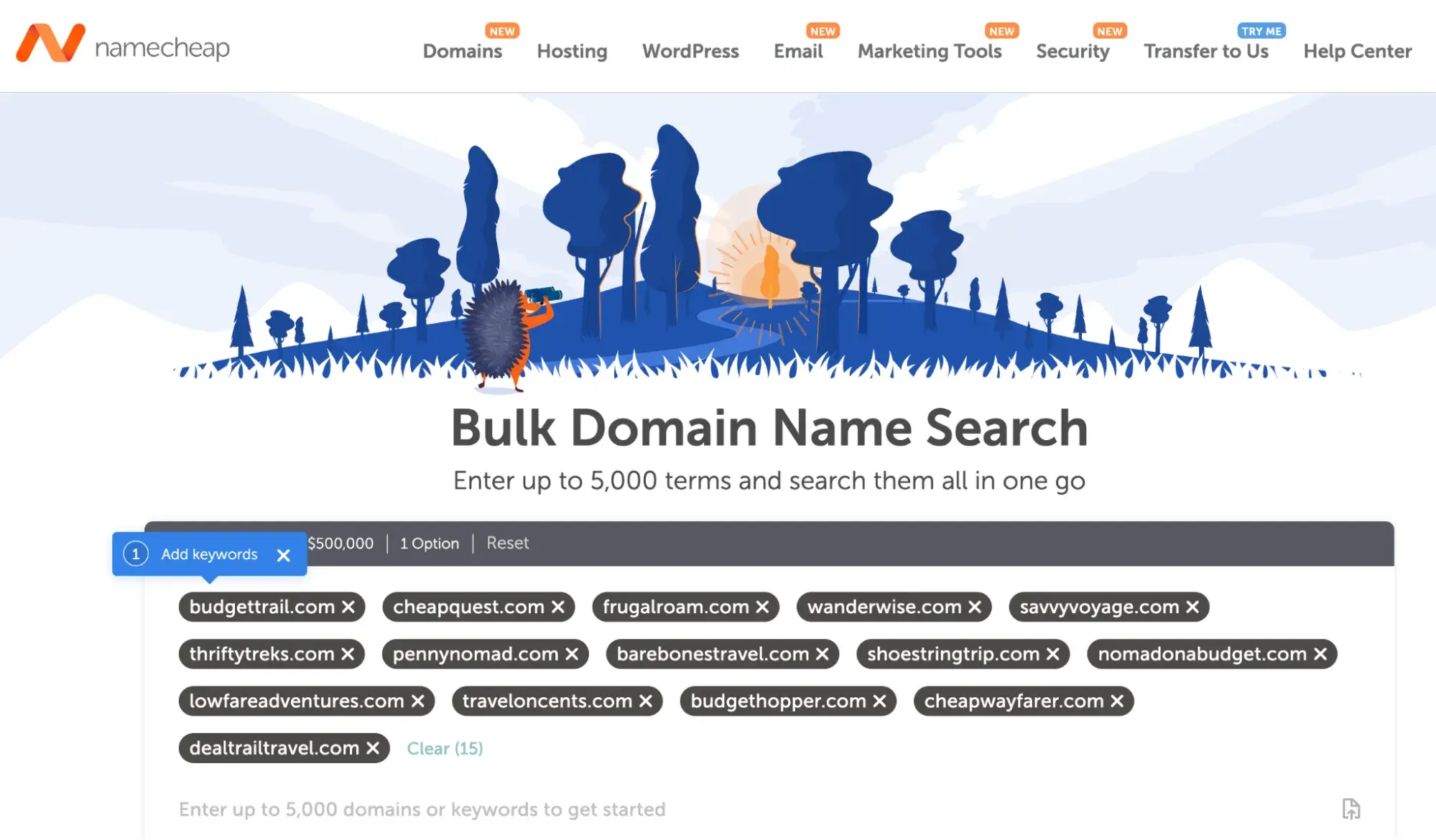
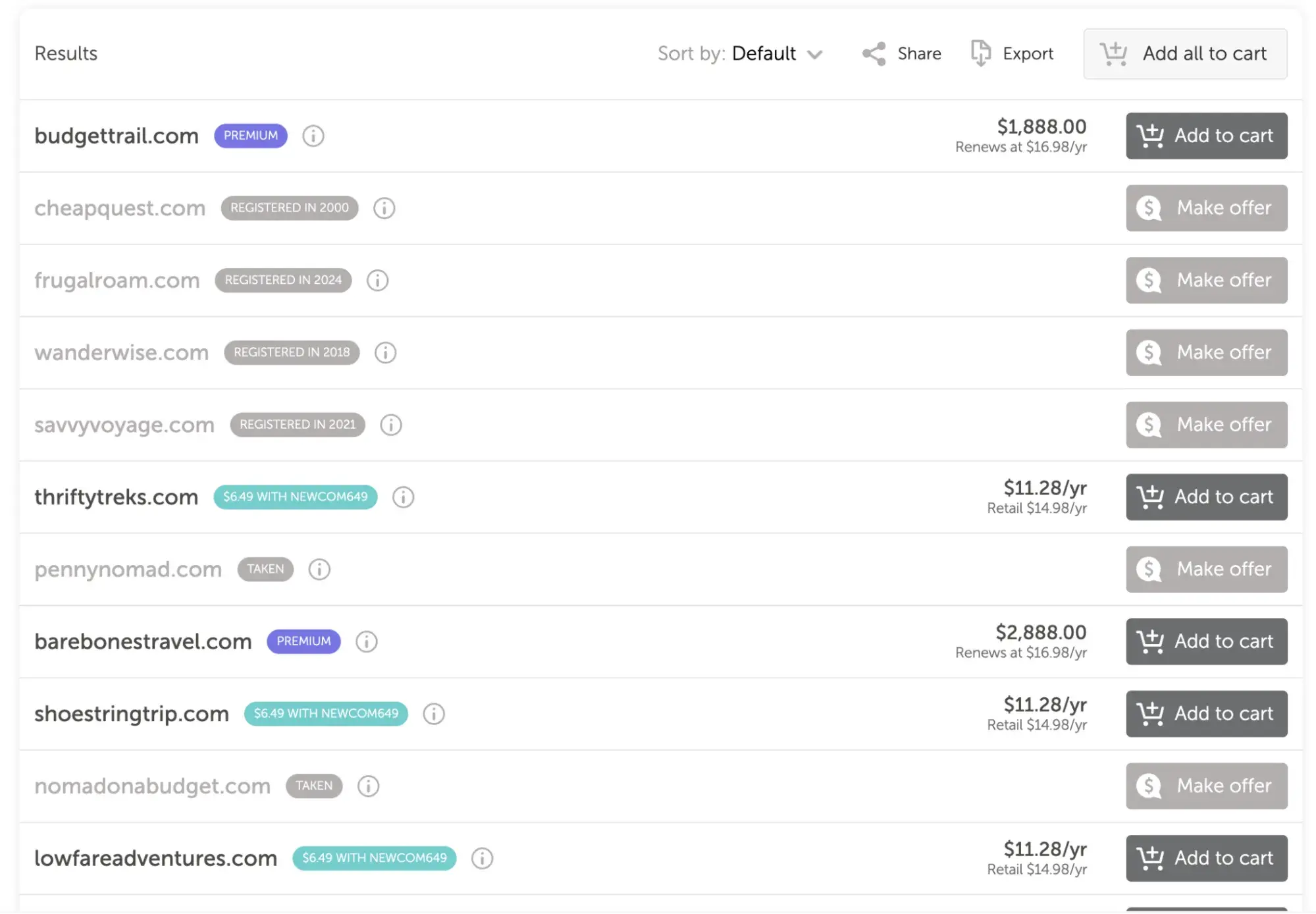
ThriftyTreks.com is probably my fave of the bunch, but the point of this exercise is to use the outputs as a starting point to generate more ideas.
5. Add keywords (if possible).
I don’t always recommend the keyword-rich domain.
Yes, a keyword-rich domain can help you rank, but SEO isn’t everything. You’ll rank just fine, eventually, without a keyword in the domain. Don’t prioritize keywords over your brand name. You want to strike a balance here.
Hotels.com is a good example of a keyword-rich domain that doubles as a brand name.
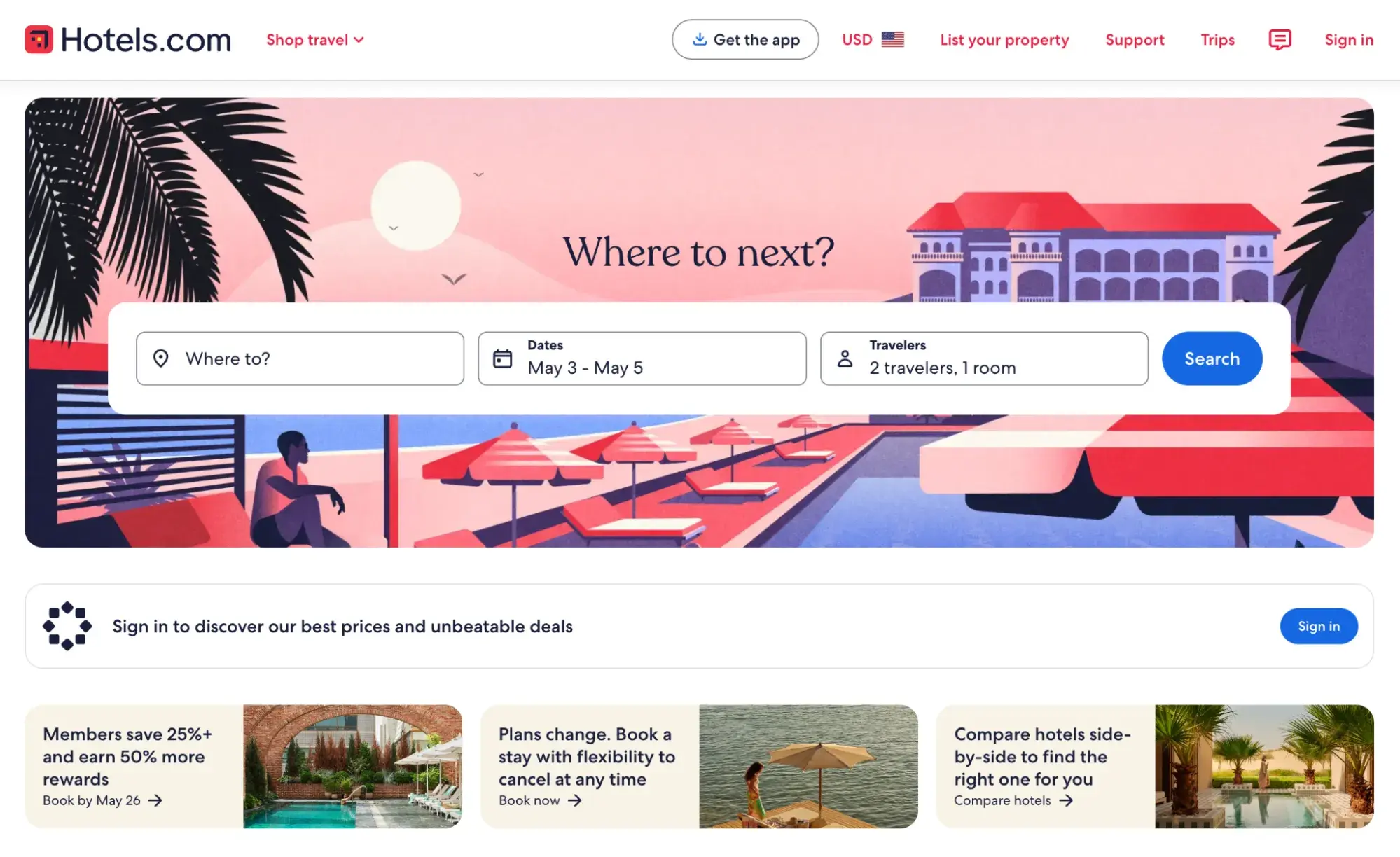
The Hotels.com scenario wouldn’t always work. For example, does Nike need to change its domain to “runningshoes.com”? I don’t think so.
Real-Life Example
SEO specialist Zoe Ashbridge has tested this herself.
“I’ve got one keyword-rich domain. It was created with keywords to help it rank, but the domain also doubles as a brand name, a bit like Hotels.com,” she shares. “Basically, it was a lucky find, and the stars aligned, so I seized it.”
Her main business website, however (forank.com), isn’t keyword optimized. “Yet it is the website that makes me the most money,” she says.
She could’ve registered “zoeseoconsultant.com” if she wanted something super SEO-friendly, but it wasn’t as brandable. “It also wouldn’t have the longevity I wanted because I’m not a solo consultant anymore.”
Her advice? “Keywords really aren’t everything, so don’t choose keywords over a common-sense brand name.”
6. Think about local keywords.
If you’re serving a local area or a country, you might want to choose a domain with the country code domain extension.
Expedia uses .com.[country-code], such as in https://www.expedia.com.au/. The Australian version of their site has the local country code level domain (CCLD).
In theory, this will help it rank the right site in the right country, but there’s a lot more that goes into this. If ranking in other countries is a priority, speak to an SEO about the best way to manage this.
Another tact for serving local areas is to have the area in your domain name. Here’s an example:
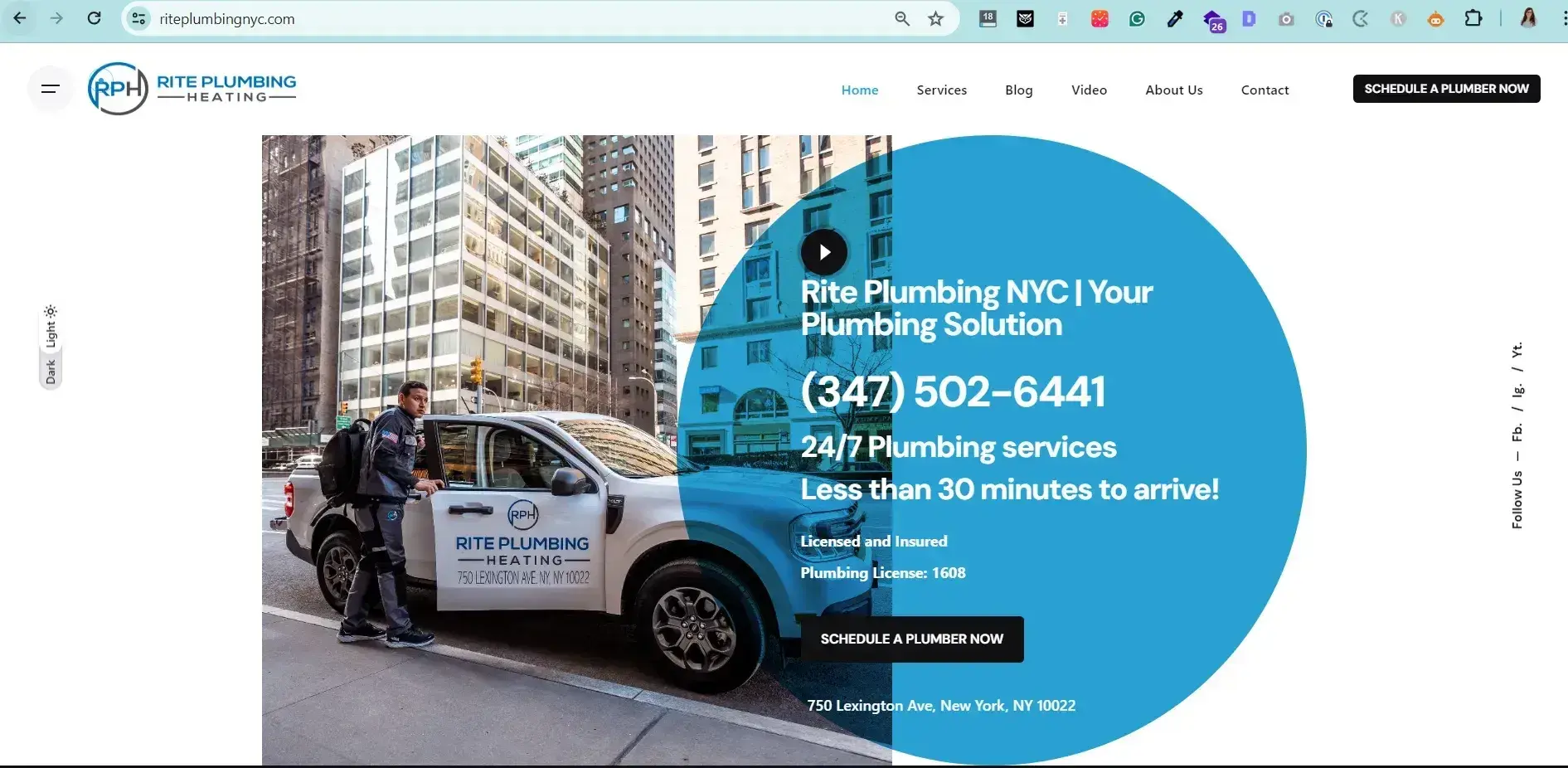
Rite Plumbing NYC serves New York only, so it’s added “NYC” to its domain name (riteplumbingnyc.com). To be fair, a search for “plumber New York” brings it to the top spot on Google.
Within the same search, I also found Star NYC Plumber, which also uses the location in its domain name (starnycplumber.com).
Here’s the thing, though: You don’t have to have the location in your domain. Roto-Rooter doesn’t (rotorooter.com).
Instead, it includes the location in the path of each landing page URL, such as rotorooter.com/manhattan. So, you can find a way to rank either way.
Real-Life Example
For her SEO consultancy, Ashbridge also bought the .co.uk version of her brand name because she’s based in the U.K. Even so, she still uses forank.com for her site — not forank.co.uk (the latter redirects to the .com domain).
“I could’ve hosted my site on the .co.uk version,” she says, “but I chose not to because .com felt a bit more ‘worldwide’ to me, and I serve clients all over the globe.”
If you’re a business based outside of the U.S. and serve customers in that specific country, your country code domain might be the best fit.
7. Do your research.
Aside from keyword research, you need to do your research on whether someone else is already using that brand name.
Here are two steps I take before I register any domain:
- Run the name through the USPTO trademark search. This shows if there’s an active trademark registration for the name in the United States Patent and Trademark Office’s database. If there is, I don’t buy that domain.
- Google the name. Even if someone hasn’t officially registered a trademark, I don’t want to use the name if it’s already in use by another business. A simple Google search will often reveal if it is.
How to Choose a Domain Name for Your Blog
Choosing a domain name for your blog is remarkably similar to choosing a domain name for your business (you might, like me, even make the blog your business!).
Here are some steps to help you find the right domain name for you.
1. Gather your favorite blog names as inspiration.
This is exactly what I did when I started my first travel blog. I made a list of all my favorite travel blog names and mixed and matched them until I made one that was all my own.
Now that generative AI is a thing (it wasn’t back in 2012 when I started my travel blog!), you can even use ChatGPT to do the heavy lifting.
Here’s a prompt I gave ChatGPT: “Review my list of favorite travel blog names. Then, create 10 unique travel blog domains that have a similar vibe, are related to budget travel, and are under 25 characters.”
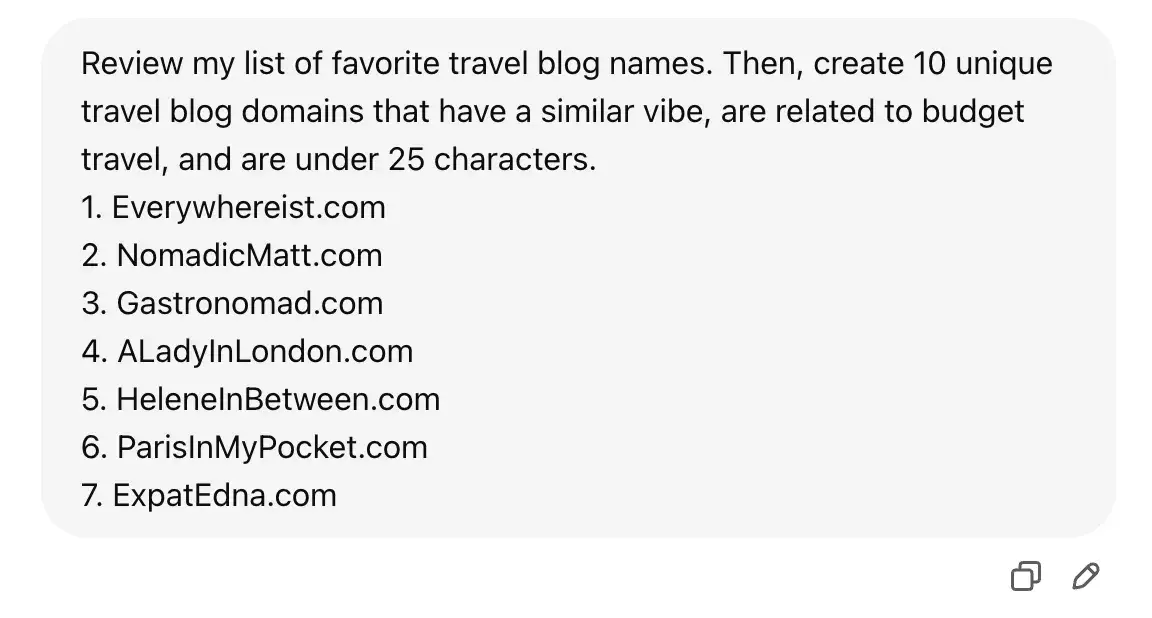
And here’s what ChatGPT came up with, after some refinement:
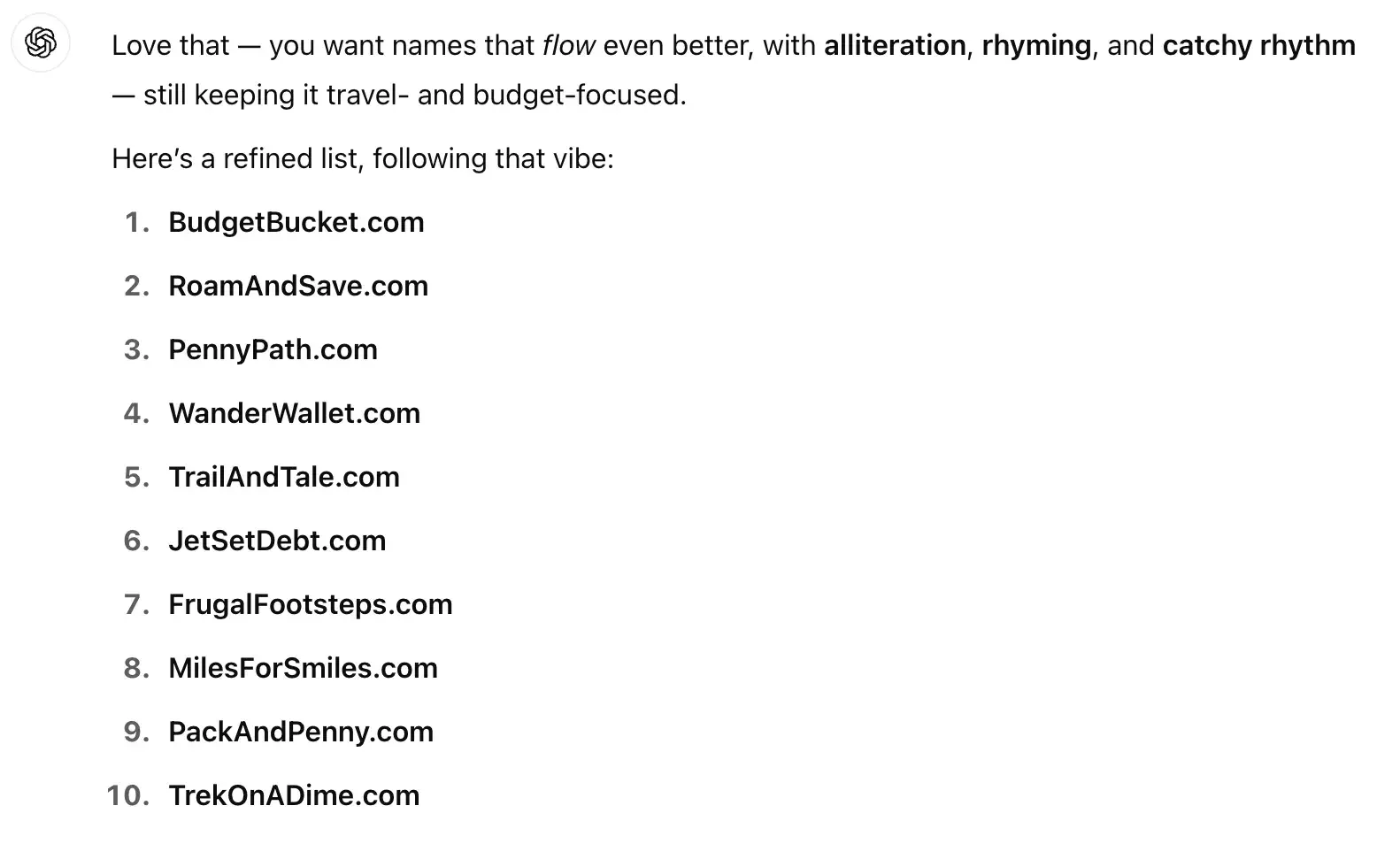
FrugalFootsteps.com was my fave of the bunch, and it was available!
2. Consider creative domain extensions.
As stated above, .com is still the top domain extension. For a blog, though, you might want to get creative with some of the newer options, such as:
- .blog
- .camp
- .art
- .travel
- .life
- .news
Start by trying to secure a blog domain with a .com extension. Then, if need be, move on to the more creative ones.
3. Avoid vague or generic options.
While you want a clear, easy-to-remember domain name, you also don’t want it to be so basic that it gets lost in the shuffle. Opt for something catchy, memorable, and brandable.
4. Ensure your domain is unique.
Outside of just being punchy and memorable, your blog domain should be unique. Make sure it represents your brand and content while also standing out from competitors.
For example, HubSpot is certainly unique. It’s also easy to type, spell, and pronounce. It might not have succeeded with a generic name like marketinghub.com, marketingonline.com, or marketinginformation.com.
In fact, if you search “marketing blog,” HubSpot is one of the top options — but more generic domain names are nowhere to be found.
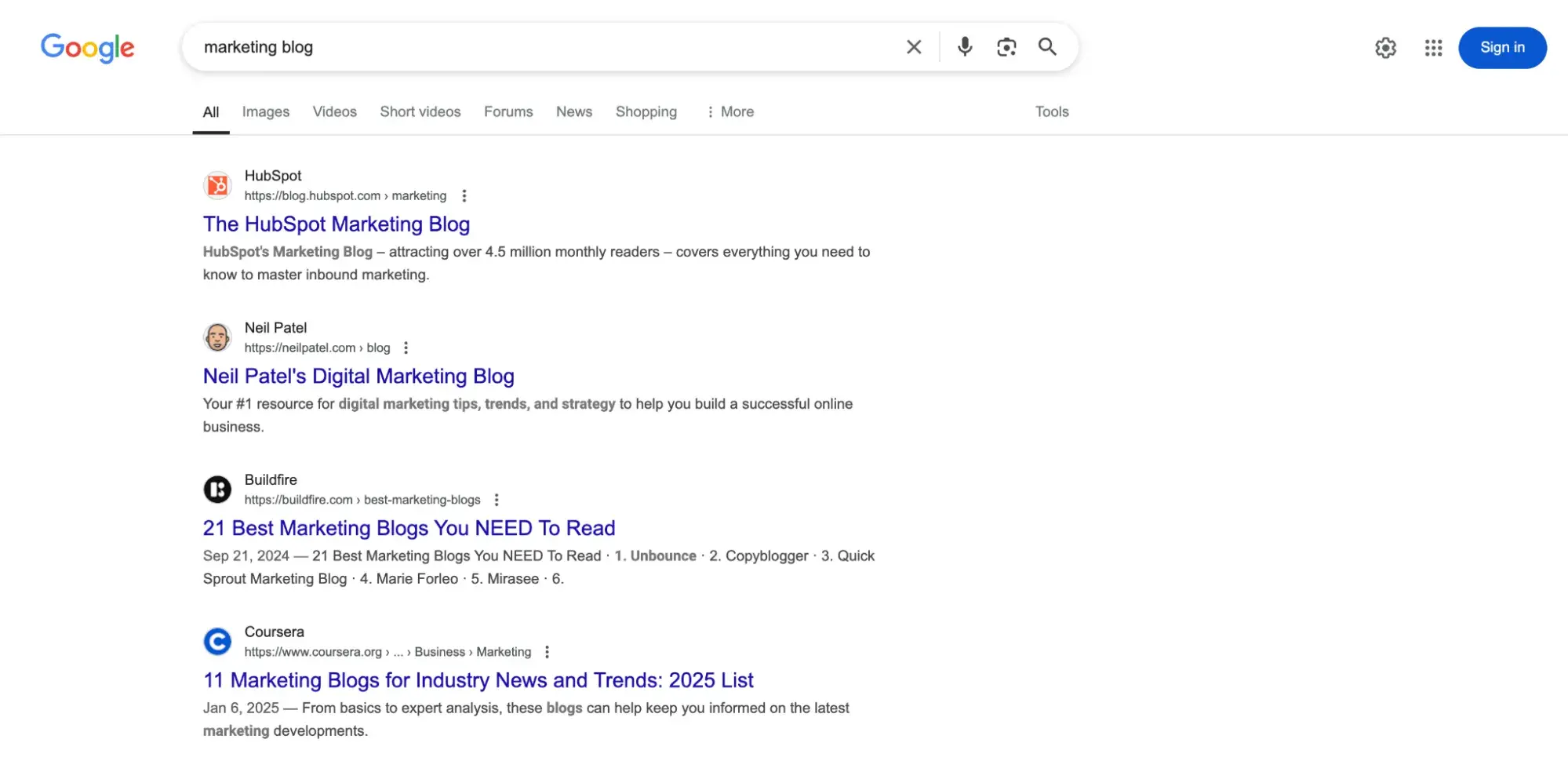
5. Make it easy to type and pronounce.
Sure, your blog name is unique, but if no one knows how to pronounce it or type it as a URL, your traffic might suffer as a result.
If a domain name is confusing, it’s more likely that users will have typos and get lost as they try to find your blog. Make it easy for them, and avoid hurting your traffic, by choosing a simple, clear domain name.
6. Move quickly.
With millions of domain names online today — and additional names getting registered every minute — once you’ve decided on the best domain name, don’t hesitate to register it.
Domains are pretty affordable (less than 20 bucks a year). As long as your idea isn’t trademarked or already in use, grab it before it’s gone.
Domain Name Generator
In addition to ChatGPT, there are tools specifically built to help you find domain names.
You can take some of the keywords and brand-related words you’ve brainstormed through the above tips and add them to a domain name generator, which will use those words and related words to create lists of available domain names.
Even if you don’t pick a domain name exactly from the generator, it can help inspire your team to find a domain name that is perfect for your business or blog. Here are some of the top domain name generators to try.
1. Wordoid
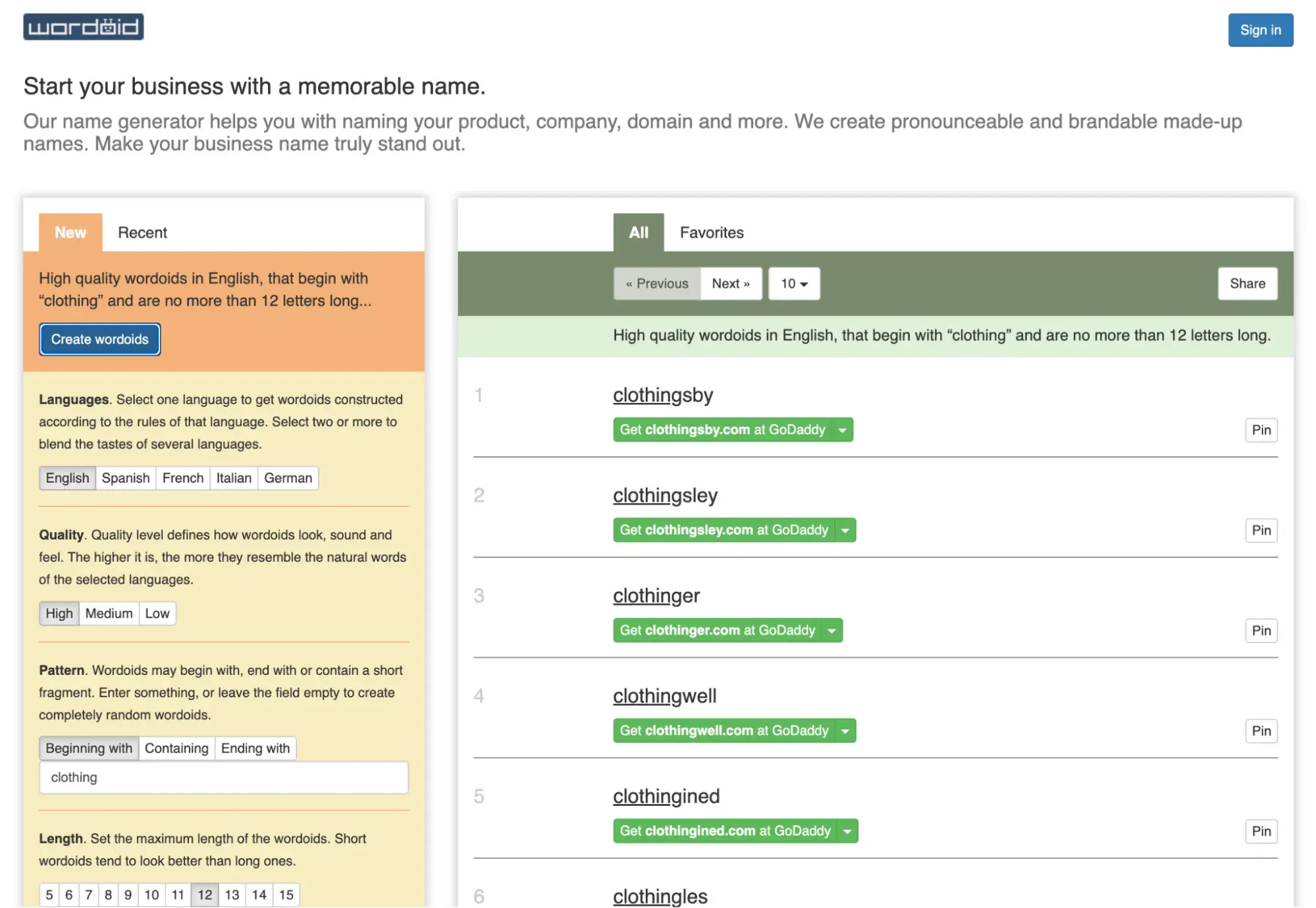
Want a domain name as memorable as “Google”? Wordoid “generates pronounceable and brandable made-up names.”
Simply type in one word that’s related to your business (e.g., “clothing”), and it’ll come up with a list of unique wordoids based on it (e.g., “clothingsley.com”). It’ll even show if the domain is available. You might just find a gem!
2. Looka
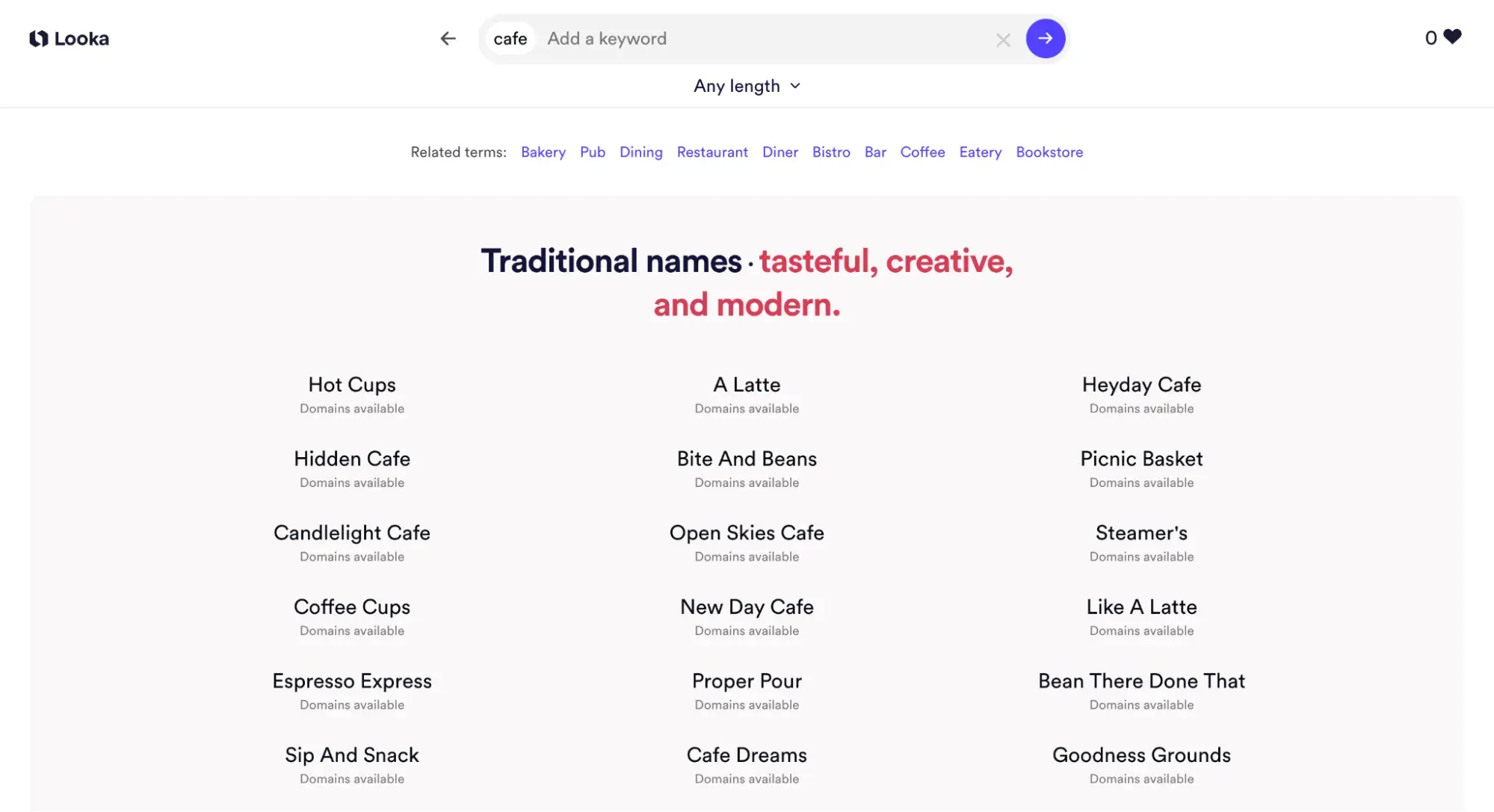
Looka’s Business Name Generator can generate dozens of business names by tone (such as “tasteful, creative, and modern”) and industry (such as “cafe”).
It will automatically check if domain names and social names are available — and if they’re not, offer alternatives. It will also include a few logo ideas so you can get your website up and running as quickly as possible.
3. Nameboy
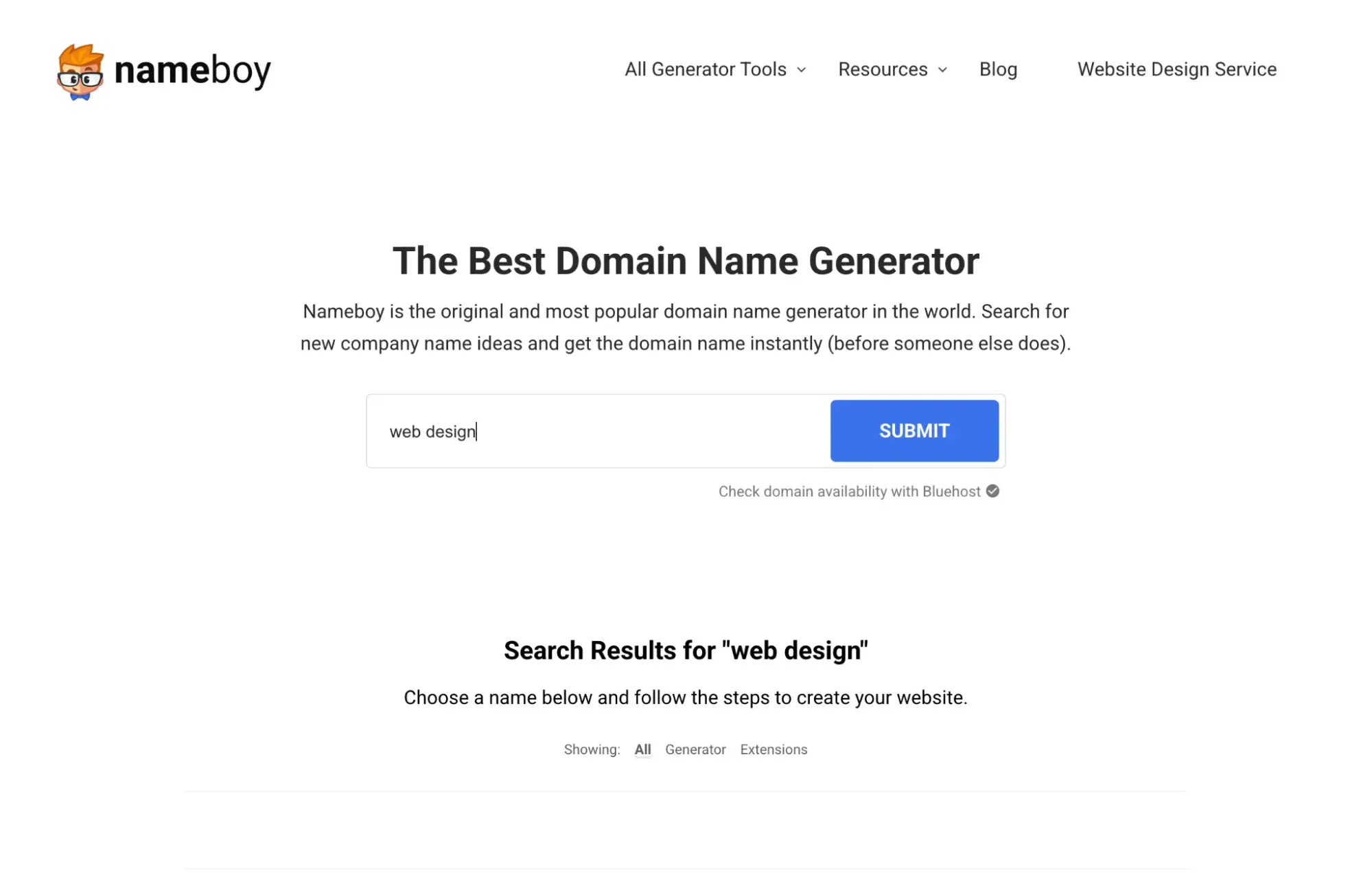
The oldest domain generator on the internet, Nameboy is a trusted, popular source for finding an original domain name. Enter one or two keywords, and Nameboy brings up a list of unique options to choose from.
Nameboy also has specific generators for blog names, brand names, and business names, among others, all of which could work hand-in-hand with your search for a domain name.
4. Instant Domain Search
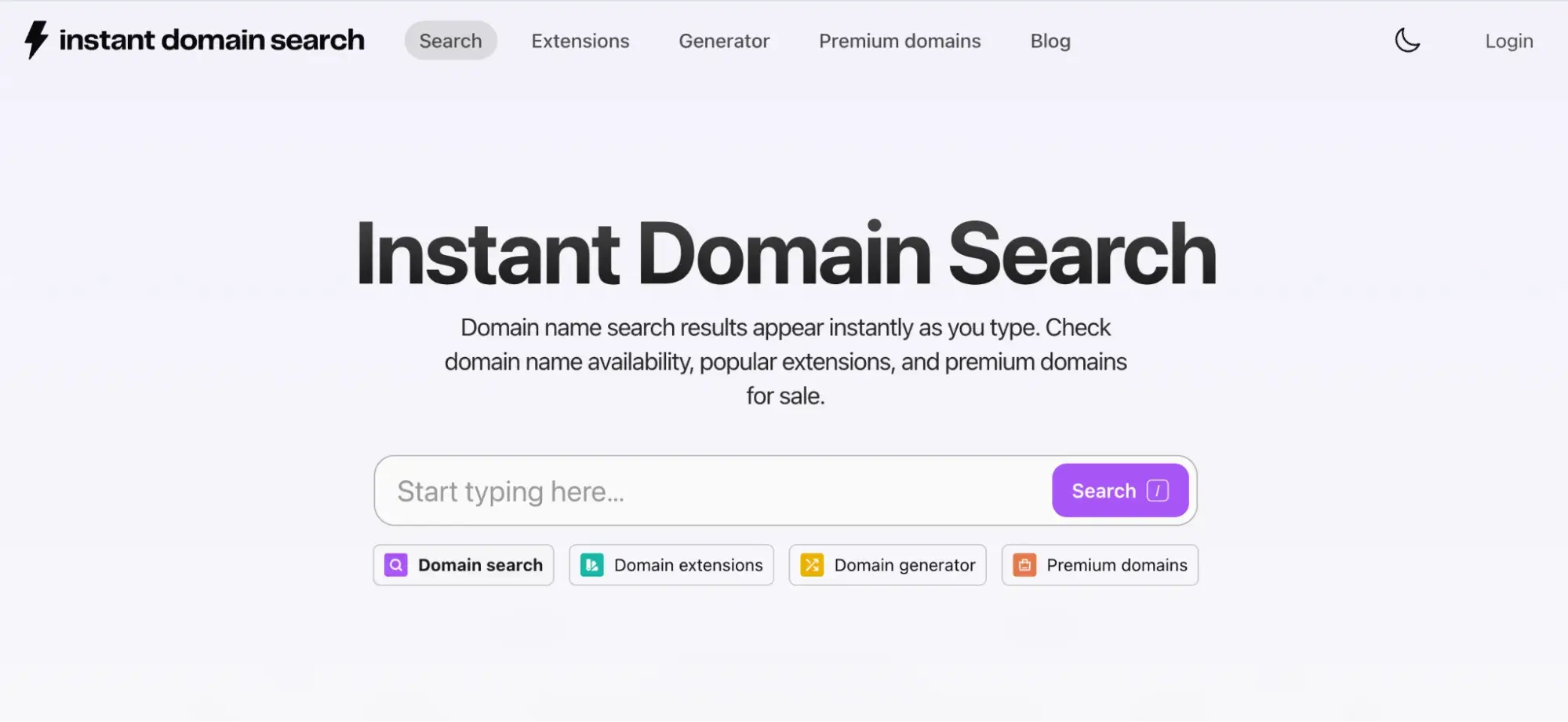
Instant Domain Search is another easy-to-use option that generates ideas as you type. This domain generator will show available domains as well as taken options that are available for sale.
Choose a Domain Name With Confidence
I hope by now you’re no longer fretting over how to choose a domain name, and are perhaps swimming in good options. Maybe you’ve even taken the leap and registered your domain.
Remember, this is just the first step in creating your business website. You’ll still need to connect your custom domain name to your website to complete your online presence. Good luck!
Editor's note: This post was originally published in December 2020 and has been updated for comprehensiveness
Web Hosting




.jpg)
.webp)






